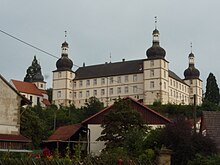Sternberg Castle
The Sternberg lock in the community Sulzdorf at the Lederhecke is a baroque four wings around a central courtyard, the corners thereof by a tower with onion dome are marked. The castle chapel adjoins the castle and faces north in the portal .
history
In the 12th century, the Henneberger received the area around Sternberg from the diocese of Eichstätt as a fief . In 1199, Count Heinrich von Henneberg-Sternberg built a castle on the site of today's palace . After the Henneberg-Sternberger line died out, the castle was sold to the Würzburg monastery in 1354 , and they gave several fiefs , so that a Ganerbeburg was created. At the beginning of the 16th century, however , the Truchseß von Wetzhausen took all of these Ganerbe shares into their possession.
During the Peasants 'War of 1525 and the Thirty Years' War , the castle was seriously affected.
Between 1667 and 1669, under Wolff Dietrich Truchseß von Wetzhausen, today's baroque complex was built, which is probably one of the largest Franconian country castles. The castle church was built in 1673, which is proven by a date on the coat of arms stone there.
After Wolff Dietrich had no male descendants, he sold the castle in 1695 to his liege lord , the Würzburg prince-bishop Johann Gottfried von Guttenberg .
The castle remained in the possession of the Barons zu Guttenberg until 1838 , who sold it to Ernst I of Saxe-Coburg and Gotha . In 1846, the then Bavarian King Ludwig I finally acquired the property from Ernst II of Saxe-Coburg and Gotha . Allegedly, Ludwig's lover Lola Montez found refuge in Sternberg Castle during her escape in 1848.
After the king's abdication in 1848, the complex changed hands several times. In 1884 the wine merchant Oskar von Deuster from Kitzingen acquired the castle, which was in a ruinous state, repaired it and created a park .
In September 1930, then Reich President Paul von Hindenburg stayed at the castle to watch the autumn maneuvers of the Reichswehr taking place in the grave field.
In 1933, the Swiss FL Alexandre Freytag bought the castle. He was the founder of the religious community " Menschenfreundliches Werk ", which is now the owner again after the castle was used as an SA training camp during the Second World War and later as a refugee camp and was transferred back at the end of the 1940s.
investment
The early baroque palace complex with its massive corner towers was built on a hill near the Büchelberg. The plan came from Father Matthias von Saarburg, who belonged to the Franciscan Reform Order of the Capuchins and had previously worked for the House of Schönborn.
He designed the building so that the individual components symbolize the course of the year. The towers pointing in the four cardinal directions stand for spring, summer, autumn and winter. The twelve chimneys stand for the months, the 52 doors for the weeks and the allegedly 365 windows for the days of the year. With the strongly protruding corner pavilions and the four wings, Sternberg shows parallels to the Aschaffenburg Castle .
literature
- Anton Rahrbach, Jörg Schöffl, Otto Schramm: Palaces and castles in Lower Franconia - A complete representation of all palaces, manors, castles and ruins in the Lower Franconian independent cities and districts . Hofmann Verlag, Nuremberg 2002, ISBN 3-87191-309-X , pp. 192-193.
Web links
- Sulzdorf an der Lederhecke community: Castles and palaces hiking trail
- Sternberg Castle in the Rhön Lexicon
Coordinates: 50 ° 15 ′ 58 ″ N , 10 ° 34 ′ 32.6 ″ E




